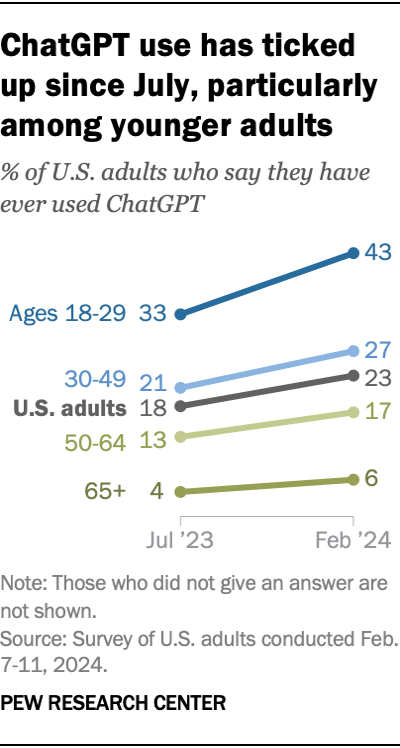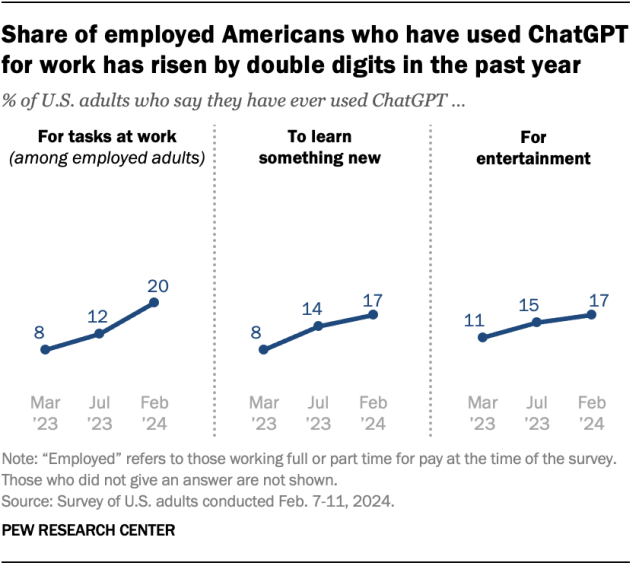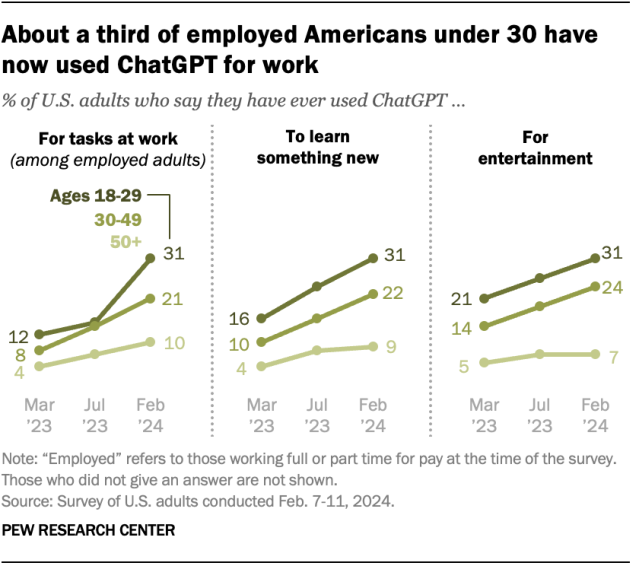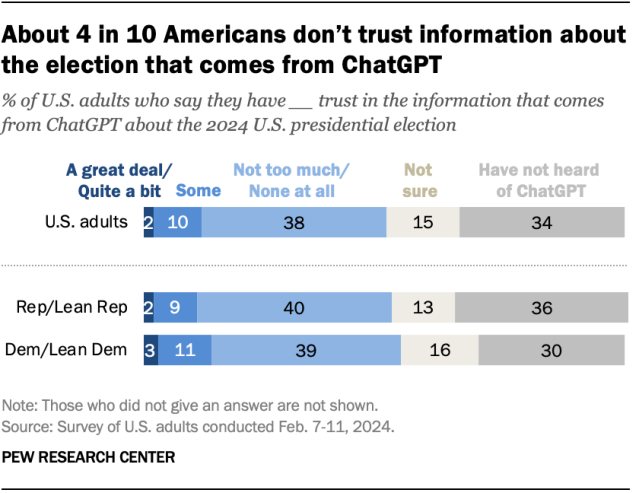It’s been more than a year since ChatGPT’s public debut set the tech world abuzz. And Americans’ use of the chatbot is ticking up: 23% of U.S. adults say they have ever used it, according to a Pew Research Center survey conducted in February, up from 18% in July 2023.
The February survey also asked Americans about several ways they might use ChatGPT, including for workplace tasks, for learning and for fun. While growing shares of Americans are using the chatbot for these purposes, the public is more wary than not of what the chatbot might tell them about the 2024 U.S. presidential election. About four-in-ten adults have not too much or no trust in the election information that comes from ChatGPT. By comparison, just 2% have a great deal or quite a bit of trust.
Pew Research Center conducted this study to understand Americans’ use of ChatGPT and their attitudes about the chatbot. For this analysis, we surveyed 10,133 U.S. adults from Feb. 7 to Feb. 11, 2024.
Everyone who took part in the survey is a member of the Center’s American Trends Panel (ATP), an online survey panel that is recruited through national, random sampling of residential addresses. This way, nearly all U.S. adults have a chance of selection. The survey is weighted to be representative of the U.S. adult population by gender, race, ethnicity, partisan affiliation, education and other categories. Read more about the ATP’s methodology.
Here are the questions used for this analysis, along with responses, and the survey methodology.
Below we’ll look more closely at:
- Which U.S. adults have used ChatGPT
- How Americans are using it
- How much Americans trust ChatGPT’s election information
Who has used ChatGPT?

Most Americans still haven’t used the chatbot, despite the uptick since our July 2023 survey on this topic. But some groups remain far more likely to have used it than others.
Differences by age
Adults under 30 stand out: 43% of these young adults have used ChatGPT, up 10 percentage points since last summer. Use of the chatbot is also up slightly among those ages 30 to 49 and 50 to 64. Still, these groups remain less likely than their younger peers to have used the technology. Just 6% of Americans 65 and up have used ChatGPT.
Differences by education
Highly educated adults are most likely to have used ChatGPT: 37% of those with a postgraduate or other advanced degree have done so, up 8 points since July 2023. This group is more likely to have used ChatGPT than those with a bachelor’s degree only (29%), some college experience (23%) or a high school diploma or less (12%).
How have Americans used ChatGPT?
Since March 2023, we’ve also tracked three potential reasons Americans might use ChatGPT: for work, to learn something new or for entertainment.

The share of employed Americans who have used ChatGPT on the job increased from 8% in March 2023 to 20% in February 2024, including an 8-point increase since July.
Turning to U.S. adults overall, about one-in-five have used ChatGPT to learn something new (17%) or for entertainment (17%). These shares have increased from about one-in-ten in March 2023.
Differences by age

Use of ChatGPT for work, learning or entertainment has largely risen across age groups over the past year. Still, there are striking differences between these groups (those 18 to 29, 30 to 49, and 50 and older).
For example, about three-in-ten employed adults under 30 (31%) say they have used it for tasks at work – up 19 points from a year ago, with much of that increase happening since July. These younger workers are more likely than their older peers to have used ChatGPT in this way.
Adults under 30 also stand out in using the chatbot for learning. And when it comes to entertainment, those under 50 are more likely than older adults to use ChatGPT for this purpose.
Differences by education
A third of employed Americans with a postgraduate degree have used ChatGPT for work, compared with smaller shares of workers who have a bachelor’s degree only (25%), some college (19%) or a high school diploma or less (8%).
Those shares have each roughly tripled since March 2023 for workers with a postgraduate degree, bachelor’s degree or some college. Among workers with a high school diploma or less, use is statistically unchanged from a year ago.
Using ChatGPT for other purposes also varies by education level, though the patterns are slightly different. For example, a quarter each of postgraduate and bachelor’s degree-holders have used ChatGPT for learning, compared with 16% of those with some college experience and 11% of those with a high school diploma or less education. Each of these shares is up from a year ago.
ChatGPT and the 2024 presidential election
With more people using ChatGPT, we also wanted to understand whether Americans trust the information they get from it, particularly in the context of U.S. politics.

About four-in-ten Americans (38%) don’t trust the information that comes from ChatGPT about the 2024 U.S. presidential election – that is, they say they have not too much trust (18%) or no trust at all (20%).
A mere 2% have a great deal or quite a bit of trust, while 10% have some trust.
Another 15% aren’t sure, while 34% have not heard of ChatGPT.
Distrust far outweighs trust regardless of political party. About four-in-ten Republicans and Democrats alike (including those who lean toward each party) have not too much or no trust at all in ChatGPT’s election information.
Notably, however, very few Americans have actually used the chatbot to find information about the presidential election: Just 2% of adults say they have done so, including 2% of Democrats and Democratic-leaning independents and 1% of Republicans and GOP leaners.
These survey findings come amid growing national attention on chatbots and misinformation. Several tech companies have recently pledged to prevent the misuse of artificial intelligence – including chatbots – in this year’s election. But recent reports suggest chatbots themselves may provide misleading answers to election-related questions.
Note: Here are the questions used for this analysis, along with responses, and the survey methodology.



